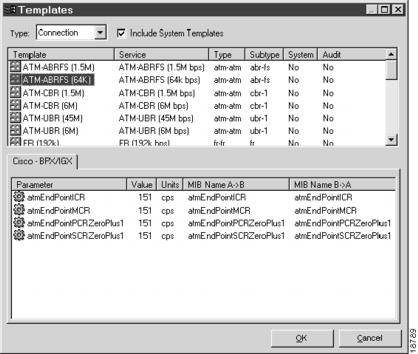 Feedback Feedback
|
Table Of Contents
Service Level Template Management
Adding Parameters to a Template
Service Level Template Management
This chapter has the following sections:
•
Adding Parameters to a Template
WSA Service Management
Under normal usage, when creating connections in a single network, WSA allows the user to simply choose a service that implies a template. A template is a predefined group of parameters used to configure the connection.
The relationship between connection Service Levels (refer to Service Levels) and Templates are most significant in multi-network or multi-vendor environments.
WSA defines a service as a group of one or more templates defined for each possible connection type required to support the service over the assigned network infrastructure.
By defining the appropriate Service Levels with a group of templates defined for each possible connection type and subtype to support the service over each individual network, WSA is able to infer the proper connection type, subtype, and QOS parameters for each assigned network infrastructure.
Services Levels Overview
A service is defined by the WSA system administrator and is assigned a unique ASCII character name.
A service includes a definition of the default connection subtypes used to support the service over different network connection types. This is required because WSA cannot infer or calculate this information. WSA can infer that ATM - FR or ATM might be required, but needs to know the default connection subtype.
For each connection type, connection subtype pair, create the template with suitable traffic parameters. Then assign the template to a specific Service Level that has a connection type and connection subtype that determine the calculation rules for WSA.
When WSA creates a connection between multiple networks, it performs a test to identify the customer port type at each end of the connection and the NNI port type at each end of the NNI link. Then the connection type is determined. WSA then looks at the corresponding Service Level inherited by the Template chosen to determine the default connection subtype.
, "", shows the calculated results determined by the default connection subtype defined in the Service Level. Note that the QOS traffic parameters are defined in the Service Template within a group of templates designed for that specific Service Level.
Table 3-1 Example of Service Connection Subtype
Templates Overview
To create a template, take a copy of an existing template and edit the parameter values as required, refer to the section Template Creation.
Templates are specific to connection types and connection subtypes (for example, ABR, VBR, and CBR). The default WSA build is supplied with default system templates and all available configured parameters for each connection and connection-subtype.
, "", lists all available QOS parameters supported by WSA for each connection type and connection subtype.
When a template is created, it is assigned to a service level from the list of already defined services.
Multi-network Services
WSA infers the connection types required from the port types on the customer ports and NNI ports. The Service Level definition is used to allow WSA to identify the connection subtype required.
Using the definition of each network segment, the required template is chosen that matches the following:
1
Connection type that customer requested
2
Connection subtype that customer requested
3
Service Level that defines the default connection subtype for each PVC segment
Template Creation
The parameters in a given template and the values for these parameters are shown in a window such as , "". Select the template editor under Tools on the menu bar to bring up the Templates window.
The same parameter can exist in many templates, but may have different values.
Figure 3-1 Template Parameters
Step 1
Select an object using the scroll bar labeled Type. The choices of Type of object are: Card, Connection, Netlink, Node, or Port.
Step 2
A list of all parameters associated with Cisco—BPX/IGX are listed.To create a new template, as shown in , "", follow these steps:
Step 1
Click the right mouse button and select the New command. A New Template window appears.
Step 2
In the Tools menu, select Copy Service level to copy existing service parameters to a new service name.
Figure 3-2 Creating a Template
Editing a Template
Select the template to edit
Click the right mouse button and adjust the Properties according to network protocols
Figure 3-3 Template Properties
Adding Parameters to a Template
To add a new parameter to the vendor template, as shown in, , "", follow these steps:
Step 1
Click the right mouse button away from any parameter and select New.
Step 2
Select the name of the new parameter.
Step 3
Add a logical value and click Add to commit the new parameter.
Notice that setting logical values for parameters within a Service Template requires the ATM/FR traffic QOS expertise. For example, to modify the frEndPointQIR parameters value, the customer must adjust the frEndPointMIR and frEndPointPIR accordingly, based on the rule that frEndPointMIR must be less than or equal to frEndPointQIR, which must be less than or equal to frEndPointPIR. The attributes for MIR, CIR, PIR, and QIR can only be set to values evenly divisible by 100... and so on.
Also note that the same template parameters might not apply to the same connection type with the same connection subtype but might be built on different type of nodes.
For example, a FR (64k) template might contain a traffic parameter frEndPointCIR with value 64000 bps and this template would suffice to provision an FR end point at AXIS node but not to provision on an IGX node. Therefore, pay attention when designing the proper templates for each network infrastructure with different connection types and connection subtype pairs for each Service Level.
Figure 3-4 Adding Parameters to Template
If no value is given, then the system will use a default. , "", shows a fully populated template.
Figure 3-5 Fully Populated Template





